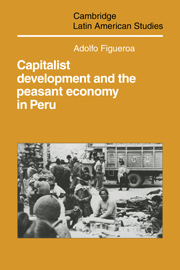Book contents
- Frontmatter
- Contents
- List of tables and figures
- Acknowledgments
- 1 Introduction
- 2 Scope and method
- 3 The economic unit and economic organization
- 4 Production and exchange
- 5 The level and structure of peasant income
- 6 The economic behavior of the peasant family
- 7 Stagnation in the peasant economy and the role of demand
- 8 Economic crisis and the peasant economy, 1975–1980
- 9 Conclusions: reality, theory and policy
- Appendixes
- Notes
- Bibliograph
- Index
- CAMBRIDGE LATIN AMERICAN STUDIES
- Frontmatter
- Contents
- List of tables and figures
- Acknowledgments
- 1 Introduction
- 2 Scope and method
- 3 The economic unit and economic organization
- 4 Production and exchange
- 5 The level and structure of peasant income
- 6 The economic behavior of the peasant family
- 7 Stagnation in the peasant economy and the role of demand
- 8 Economic crisis and the peasant economy, 1975–1980
- 9 Conclusions: reality, theory and policy
- Appendixes
- Notes
- Bibliograph
- Index
- CAMBRIDGE LATIN AMERICAN STUDIES
Summary
Hypotheses on peasant economies
The persistence of poverty in the peasant economy in Latin America calls for an explanation. For this, the study of the functioning of the peasant economy and its relation to the rest of the economic system is required. In fact, the relevant hypotheses can be classified according to the emphasis given either to the production process or to the process of exchange as the main cause of the economic backwardness of the peasantry.
The production process
There are two common views concerning peasant economies: (1) they are inefficient in their use of resources; (2) they are overpopulated, due to the absence of capitalist rules of production and distribution. Against these two hypotheses, Professor Theodore Schultz (1964) has developed a new proposition in terms of ‘traditional agriculture’. His hypothesis is basically the following: there is no significant inefficiency or overpopulation in peasant economies. Poverty here can be explained by the poor quality of resources and the traditional technology in use. Peasant families are poor but efficient. As he put it: ‘the community is poor because the factors on which the economy is dependent are not capable of producing more under existing circumstances. Conversely, … the observed poverty is not a consequence of any significant inefficiencies in factor allocation’ (p. 48).
In a dynamic sense, Schultz argues that ‘the factors of production on which a community depends are expensive sources of economic growth’ (p. 97).
- Type
- Chapter
- Information
- Publisher: Cambridge University PressPrint publication year: 1984

